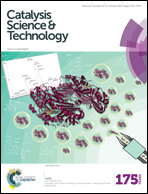High yield production of HMF from carbohydrates over silica–alumina composite catalysts†
Abstract
An efficient and selective production of 5-hydroxymethylfurfural (HMF) from carbohydrates is achieved in the presence of mesoporous AlSiO catalysts in a THF/H2O–NaCl biphasic system. These mesoporous AlSiO catalysts are prepared by a facile sol–gel method and have tunable acidity. Their acidic sites are characterized and quantified by NH3-TPD, microcalorimetry of NH3 adsorption and Py-FTIR, then correlated with the catalytic isomerization and dehydration of glucose to HMF. The detailed studies show that the AlSiO-20 catalyst with a Si/Al ratio of 18 is favorable for HMF production due to its inherently high surface area, high amounts of acid sites and a suitable Brønsted/Lewis acid ratio. Over the AlSiO-20 catalyst, an HMF yield of 63.1% is obtained at 160 °C for 1.5 h in the biphasic THF/H2O–NaCl medium with 10 wt% glucose in water. Further conducting the amplification experiment 30 times, the HMF yield still reaches 60.2% and the yield has no obvious decline after four catalytic cycles; this is the best result for an amplification experiment of HMF from glucose over a heterogeneous catalyst so far. After separation, HMF can be used for the production of 2,5-furandicarboxylic acid (FDCA) and as high as 95% FDCA yield is obtained over the Pt/C catalyst. Furthermore, the AlSiO catalyst demonstrates excellent activity in the conversion of disaccharides, polysaccharides and even lignocellulosic biomass, indicating it would be a promising catalyst for the conversion of glucose and glucose-based carbohydrates to HMF in industry applications.


 Please wait while we load your content...
Please wait while we load your content...